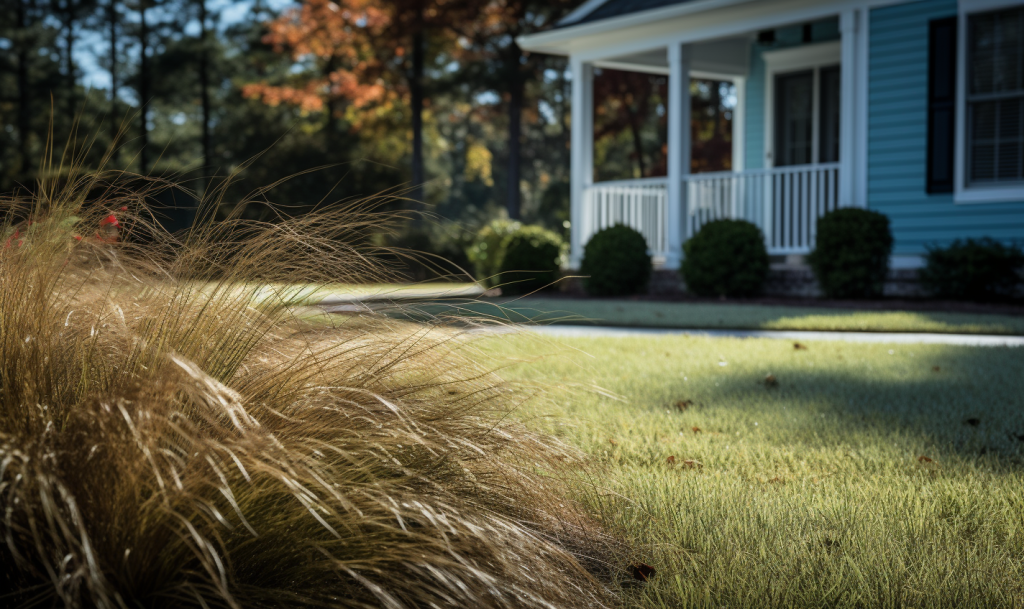Fall in Georgia heralds a transition for lawns, an essential period to prepare them for the impending winter months. The state’s diverse grass types—warm-season and cool-season varieties—require specific care to ensure their health and resilience.
Warm-Season Grasses:
1. Bermuda Grass
Fall Care: As temperatures cool, Bermuda grass enters dormancy. However, you can help fortify its roots by overseeding with winter rye for a green cover during dormancy. Fertilize with a phosphorus-rich blend to aid root development, and mow at a lower height before winter sets in.
2. Zoysia Grass
Fall Care: Zoysia grass experiences slowed growth during fall. Prepare it for the colder months by fertilizing with a balanced nitrogen-phosphorus-potassium (N-P-K) ratio. Remove fallen leaves to prevent matting and diseases, and consider aerating to alleviate soil compaction.
3. Centipede Grass
Fall Care: Centipede grass thrives in acidic soils. Conduct a soil pH test and amend accordingly. Fertilize with low-nitrogen fertilizer, refrain from heavy thatch removal, and reduce watering to allow for natural dormancy.

Cool-Season Grasses:
1. Fescue Grass
Fall Care: Fescue grass flourishes in the cooler temperatures of fall. Overseed to fill in bare spots, aerate the soil to improve oxygen penetration, and apply a balanced fertilizer to boost growth. Regular mowing at a slightly higher height is advisable.
2. Kentucky Bluegrass
Fall Care: Kentucky bluegrass benefits from fall maintenance. Aerate compacted soil, overseed thin areas, and apply a slow-release nitrogen fertilizer. Keep an eye on water levels; despite the cooler weather, ensure adequate hydration to prevent stress.
Here are some product recommendations and links for fertilizers and herbicides suitable for different grass types in Georgia:
Warm-Season Grasses:
- Bermuda Grass:
- Fertilizer: Scotts Turf Builder WinterGuard Fall Lawn Food
- Herbicide: Bayer Advanced All-In-One Lawn Weed and Crabgrass Killer
- Zoysia Grass:
- Fertilizer: Pennington UltraGreen Lawn Fertilizer
- Herbicide: Spectracide Weed Stop for Lawns
- Centipede Grass:
- Fertilizer: The Andersons PGF Complete 16-4-8 Fertilizer
- Herbicide: Ortho Weed B Gon Weed Killer for Lawns
Cool-Season Grasses:
- Fescue Grass:
- Fertilizer: Espoma Organic Fall Winterizer
- Herbicide: Preen Extended Control Weed Preventer
- Kentucky Bluegrass:
- Fertilizer: Miracle-Gro Water Soluble Lawn Food
- Herbicide: Roundup For Lawns Ready-to-Use
These products are commonly used for each grass type and can be effective for fertilizing or controlling weeds. Always follow manufacturer instructions and consider factors such as your lawn size, local regulations, and specific needs before applying any products.
Winter Maintenance: Nurturing Dormant Lawns
Winter in Georgia can vary in severity, affecting dormant grasses differently. While the lawns may appear asleep, they still require care to emerge vibrant and healthy in the spring.

General Winter Care Tips:
- Soil Aeration: Perform aeration to alleviate soil compaction, promoting oxygen and nutrient circulation.
- Minimal Foot Traffic: Minimize foot traffic on dormant lawns to prevent damage to delicate grass blades.
- Weed Control: Tackle winter weeds proactively by spot-treating with herbicides approved for specific grass types.
- Mulching: Mulch fallen leaves to prevent suffocation of grass and facilitate nutrient absorption.
For Warm-Season Grasses:
- Reduce Watering: Scale back on irrigation but ensure occasional deep watering to prevent desiccation.
- Fertilizer Application: Avoid nitrogen-rich fertilizers during dormancy. Opt for phosphorus and potassium to support root health.
For Cool-Season Grasses:
- Maintain Moisture Levels: Keep an eye on moisture levels; winter dryness can impact cool-season grasses. Water infrequently but deeply.
- Snow Management: If snowfall occurs, gently remove excessive snow to prevent matting and snow mold formation.

Recommended Timelines for Lawn Care Activities:
- Early Fall (September – Early October):
- Overseed Bermuda grass with winter rye for a green cover during dormancy.
- Apply phosphorus-rich fertilizer to aid root development for warm-season grasses.
- Conduct soil pH tests for centipede grass and amend accordingly.
- Begin aerating Zoysia grass to prepare for colder months.
- Mid-Fall (Mid-October – November):
- Fertilize Zoysia and Centipede grasses with balanced N-P-K ratio fertilizers.
- Remove fallen leaves from Zoysia and Kentucky Bluegrass to prevent matting and diseases.
- Perform aeration on Fescue and Kentucky Bluegrass to improve soil oxygenation.
- Consider overseeding thin areas of Fescue grass for better coverage.
- Late Fall (November – December):
- Apply slow-release nitrogen fertilizers to Kentucky Bluegrass.
- Monitor water levels for cool-season grasses to prevent dehydration.
- Prepare for potential snowfall by gently removing excessive snow from the lawn.
- Winter (December – February):
- Perform occasional deep watering for warm-season grasses to prevent desiccation.
- Spot-treat winter weeds with approved herbicides for specific grass types.
- Keep an eye on moisture levels for cool-season grasses to counter winter dryness.
- Early Spring (Late February – March):
- Begin preparation for spring by reducing watering for warm-season grasses.
- Consider fertilizing cool-season grasses to support their growth as temperatures rise.
- Resume regular mowing routines for both warm and cool-season grasses.
Conclusion:
Your lawn’s well-being hinges on proper care during the fall preparation and winter maintenance periods. Tailoring your efforts to the unique needs of warm and cool-season grasses is key to ensuring a vibrant and resilient lawn when spring arrives. By adhering to these guidelines, your lawn will thrive, no matter the season, and greet the warmer months with vigor and vitality.

